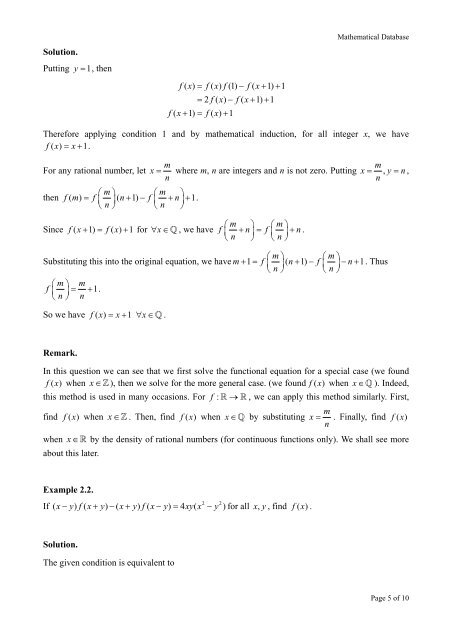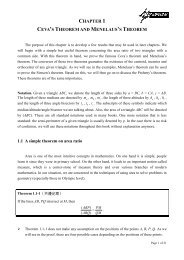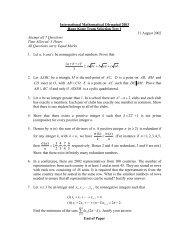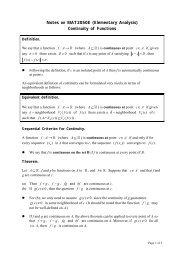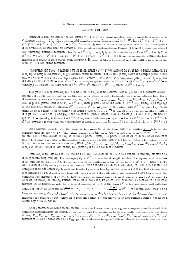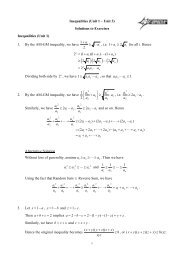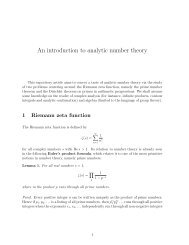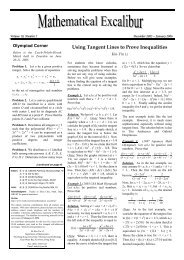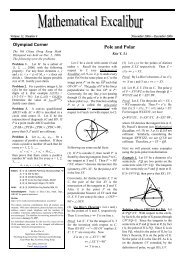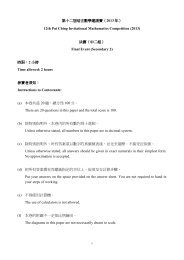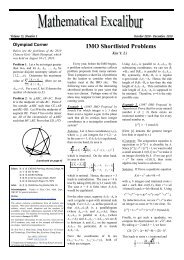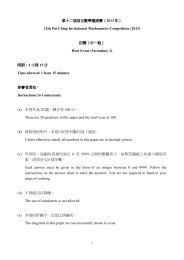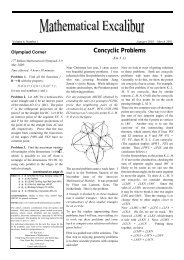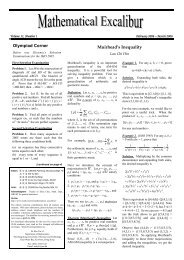1. Functional equations in one variable
1. Functional equations in one variable
1. Functional equations in one variable
You also want an ePaper? Increase the reach of your titles
YUMPU automatically turns print PDFs into web optimized ePapers that Google loves.
Solution.<br />
Putt<strong>in</strong>g<br />
y = 1, then<br />
Mathematical Database<br />
f( x) = f( x) f(1) − f( x+ 1) + 1<br />
= 2 f( x) − f( x+ 1) + 1<br />
f( x+ 1) = f( x) + 1<br />
Therefore apply<strong>in</strong>g condition 1 and by mathematical <strong>in</strong>duction, for all <strong>in</strong>teger x, we have<br />
f ( x) = x+ <strong>1.</strong><br />
m<br />
m<br />
For any rational number, let x = where m, n are <strong>in</strong>tegers and n is not zero. Putt<strong>in</strong>g x = , y = n,<br />
n<br />
n<br />
⎛<br />
then ( ) m ⎞ ⎛m<br />
⎞<br />
f m = f ⎜ ⎟( n+ 1) − f ⎜ + n⎟<br />
1<br />
⎝ n ⎠ ⎝ n ⎠ + .<br />
S<strong>in</strong>ce f( x+ 1) = f( x)<br />
+ 1 for ∀x<br />
∈ , we have<br />
⎛m<br />
⎞ ⎛m⎞<br />
f ⎜ + n⎟= f ⎜ ⎟+n.<br />
⎝ n ⎠ ⎝ n ⎠<br />
⎛m⎞ ⎛m⎞<br />
Substitut<strong>in</strong>g this <strong>in</strong>to the orig<strong>in</strong>al equation, we have m+ 1 = f ⎜ ⎟( n+ 1) − f ⎜ ⎟−n+ <strong>1.</strong> Thus<br />
⎝ n ⎠ ⎝ n ⎠<br />
⎛m⎞ m<br />
f ⎜ ⎟ = + <strong>1.</strong><br />
⎝ n ⎠ n<br />
So we have f ( x) = x+ 1 ∀x<br />
∈ .<br />
Remark.<br />
In this question we can see that we first solve the functional equation for a special case (we found<br />
f ( x ) when x ∈ ), then we solve for the more general case. (we found f ( x ) when x ∈ ). Indeed,<br />
this method is used <strong>in</strong> many occasions. For<br />
f<strong>in</strong>d<br />
when<br />
f ( x ) when<br />
x∈<br />
about this later.<br />
x ∈ . Then, f<strong>in</strong>d f ( x ) when x ∈ by substitut<strong>in</strong>g<br />
f : →<br />
, we can apply this method similarly. First,<br />
m<br />
x = . F<strong>in</strong>ally, f<strong>in</strong>d f ( x )<br />
n<br />
by the density of rational numbers (for cont<strong>in</strong>uous functions only). We shall see more<br />
Example 2.2.<br />
If<br />
2 2<br />
( x y) f( x y) ( x y) f( x y) 4 xy( x y )<br />
− + − + − = − for all x,<br />
y , f<strong>in</strong>d f ( x ).<br />
Solution.<br />
The given condition is equivalent to<br />
Page 5 of 10


